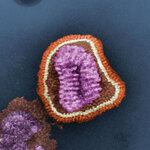Immunology

During the pandemic we have all become familiar with a lot of epidemiological concepts.
One that was introduced to us early in 2020 is the “basic reproductive number”, or R0. This tells us about the intrinsic contagiousness of a virus, or its inherent capacity to be spread from one person to another in a particular population.
We also learned about the “effective reproductive number”, or Reff. This tells us about the rate at which a virus is actually spreading through that population.
With the emergence of BA.4/5, there has been some confusion around how these concepts help us to understand…

Medicines are not normally needed to treat monkeypox. The illness is usually mild and most people infected will recover within a few weeks without needing treatment. But there are vaccines that can be used to control monkeypox outbreaks, which some countries are already using. And treatments do exist for those who become quite ill from the virus.
Monkeypox belongs to the Orthopoxvirus genus of viruses, which includes smallpox. Luckily, due to something called cross-protection, smallpox vaccines also work for monkeypox.
Although the world was declared free of smallpox in 1980, many countries…

Prior to the latest coronavirus pandemic, many were indifferent about getting the flu vaccine. They shouldn't be. Co-infections are not common but a new study finds that adults in hospital who have COVID-19 and the flu at the same time are at much greater risk of severe disease and death - over four times more likely to require ventilation support and 2.4 times more likely to die than if they only had COVID-19.
The pool was more than 305,000 hospitalized patients with COVID-19 and the results are from part of the International Severe Acute Respiratory and emerging Infection Consortium’s (…

COVID-19 vaccines have shown to be effective at preventing vaccines but the big win for public health is reduced effects if you get it anyway. If you don't have co-morbidities your relative risk is very low but if you do have them, every precaution is worth taking.
The vaccines come in many forms but two of note are the Janssen COVID-19 vaccine (Ad26.COV2.S) and Pfizer-BioNTech
(BNT162b2), distinct because Janssen only requires one dose. And the latter made "mRNA" part of the cultural lexicon.
Which one led to fewer hospitalizations? They were both outstanding but there is a…

Thankfully, most people who get COVID–19 don’t become seriously ill – especially those who are vaccinated. But a small fraction do get hospitalized, and a smaller fraction do die. If you are vaccinated and catch the coronavirus, what are your chances of getting hospitalized or dying?
As an epidemiologist, I have been asked to respond to this question in one form or another throughout the pandemic. This is a very reasonable question to ask, but a challenging one to answer.
To calculate the risk of hospitalization or death after getting infected with SARS-CoV-2 you need to know the total…

The rise of the omicron variant has caused havoc around the world, just as the emergence of the delta and alpha variants did before. A pattern has emerged, with the world scrambling to respond to a new form of the coronavirus every six or so months. How can we reduce the risk of new variants appearing again and again?
Firstly, let’s consider how they emerge. A virus reproduces by making copies of itself. Every time it replicates, there’s a tiny chance that an error occurs in the copying of the virus’s genetic sequence.
This causes a mutation to the new copy of the virus, which has three…

The ongoing SARS-CoV-2 pandemic and new mutations in viral genetic sequences have made "variant" part of the cultural lexicon, because they can have significant impacts on the virus’s transmissibility and the damage it causes.
Researchers have long been concerned that could happen in the HIV-1 virus, which has been mitigated thanks to safer sex practices and modern science but still affects 38 million people worldwide.
A new, highly virulent HIV strain has erupted in the Netherlands and individuals infected with the new “VB variant” (for virulent subtype B) showed significant…

This is the third coronavirus pandemic of this century, after SARS and MERS, and due to that many forget that influenza is a chronic killer, 40-60,000 deaths in America alone each year. To mitigate those effects, there is a seasonal flu vaccine. Each year researchers model how they expect the virus to mutate and then they create a vaccine based on that. Some years are more successful than others but if people do get the flu, effects will be reduced.
A new study also shows that annual flu vaccines increasingly help protect young people during flu pandemics. Kids who receive years of season-…

A recent study finds that chewing gum laced with a plant-grown protein named ACE2 serves as a “trap” for the SARS-CoV-2 virus, reducing viral load in saliva and potentially tamping down transmission.
Vaccinations for COVID-19 have begun to stamp out the pandemic but even people who are fully vaccinated can still become infected with SARS-CoV-2. Scientists are on the hunt for new ways to neutralize the virus before it can harm people with co-morbidities.
“SARS-CoV-2 replicates in the salivary glands, and we know that when someone who is infected sneezes, coughs, or speaks some of that virus…

Coronavirus has been with us for thousands of years and has mutated accordingly. Since it is in the same family as the common cold it was only recognized as distinct a few decades ago, and in the past severe cases were likely just treated as a flu.
But after SARS in 2003 and MERS a decade later, coronavirus has taken the world stage and it is never leaving the lexicon again. Every detected mutation is splashed across media outlets with no end in sight. Nearly everyone has to have been exposed at this point but well over 99 percent are unaffected and that leads to questions about how much more…